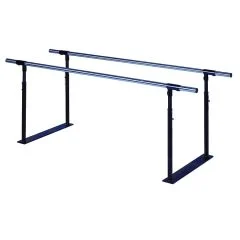It is believed that Friedrich Ludwig Jahn invented the parallel bars in Germany in the 1810s. Jahn was the founder of the German system of gymnastic based on multiple apparatuses and underpinned by a political and patriotic ideology. He first used poles dug into the ground to assist gymnasts to prepare for use of the vaulting horse and then made his parallel bars by nailing two bars onto tree boles.
The male gymnastic movement started by Jahn moved across Europe and to America. Along with the gymnastics, the parallel bars’ design also evolved. In the mid-19th century, in Berlin, Paris and London, special institutes were established for the treatment and rehabilitation of young women with disabilities; possibly the genesis of the parallel bars as a standard piece of equipment in the physiotherapy gym.
In 1955 Cicenia and Hoberman publish a detailed text and diagrams giving examples of the use of the bars in rehabilitation, noting that parallel bar work was “unquestionably of paramount importance as a means of attaining a high level of proficiency in perambulation fundamentals.” Exercises are described which are transferable to crutch walking and initial practice of this is recommended in wider parallel bars.
In 2014 the International Committee of the Red Cross published recommended architectural features for rehabilitation centres. Two four-metres long parallel bars were recommended for a three staffed physiotherapy department managing ten patients along with other staples including mobile mirror, treatment table, stool on wheels, trampoline, pulley machine, treadmill, tilt table and standing frame.
Description provided by Susan Waller of United Arab Emirates
References:
Kaimakamis V, Papadopoulos P, Kaimakamis D & Duka S. 2010. Invention and evaluation of the parallel bars in the first half of the 19th century. Studies in Physical Culture and Tourism, 17 (2), 167-172.
Cicenia E and Hoberman M. 1955. Parallel bar activities in physical therapy and rehabilitation. American Journal of Physical Medicine and Rehabilitation, 34(6), 591-605.
International Committee of the Red Cross. 2014. Physical Rehabilitation Centres. Architectural Programming Handbook.

